Hybrid Z-Source Circuit Breaker with Thomson Coil for MVDC
Abstract
:1. Introduction
- A new bi-directional hybrid DC circuit breaker topology.
- No or minimal arc operation.
- High reliability through fault isolation at current zero crossing.
- Fast fault detection in low impedance fault.
- IGBT, MOV stress, and size reduction.
2. Proposed Hybrid Z-Source Circuit Breaker
2.1. Operating Principle
2.2. Current Zero Crossing Time
2.3. Breaking Time
2.4. Prevention of Re-Ignition and Insulation Breakdown
3. Thomson Coil Actuator Operation Design
3.1. Thomson Coil Actuator Overview and Construction
3.2. Finite Element Modeling and Operating
4. Experiment Analysis
4.1. Experimental Setup
4.2. Experimental Control
4.3. Experimental Results
5. Conclusions
Author Contributions
Funding
Institutional Review Board Statement
Informed Consent Statement
Data Availability Statement
Conflicts of Interest
References
- Liao, J.; Zhou, N.; Qin, Z.; Purgat, P.; Wang, Q.; Bauer, P. Coordination control of power flow controller and hybrid DC circuit breaker in MVDC distribution networks. IEEE Mod. Power Syst. Clean Energy 2021, 9, 1257–1268. [Google Scholar] [CrossRef]
- He, Z.; Hu, J.B.; Lin, L. Pole-to-ground Fault Analysis for HVDC Grid Based on Common-and Differential-mode Transformation. J. Mod. Power Syst. Clean Energy 2020, 8, 521–530. [Google Scholar] [CrossRef]
- Xu, J.; Zhao, X.; Han, N. A thyristor-based DC fault current limiter with inductor inserting-bypassing capability. IEEE J. Emerg. Sel. Top. Power Electron. 2019, 7, 1748–1757. [Google Scholar] [CrossRef]
- Hategekimana, P.; Ferre, A.J.; Bernuz, J.M.R.; Ntagwirumugara, E. Fault Detecting and Isolating Schemes in a Low-Voltage DC Microgrid Network from a Remote Village. Energies 2022, 15, 4460. [Google Scholar] [CrossRef]
- Franck, C.M. HVDC Circuit Breakers: A Review Identifying Future Research Needs. IEEE Trans. Power Deliv. 2011, 26, 998–1007. [Google Scholar] [CrossRef]
- Pei, X.; Cwikowski, O.; Vilchis-Rodriguez, D.S.; Barnes, M.; Smith, A.C.; Shuttleworth, R. A review of technologies for MVDC circuit breakers. In Proceedings of the IECON 2016—42nd Annual Conference of the IEEE Industrial Electronics Society, Florence, Italy, 23–26 October 2016; pp. 3799–3805. [Google Scholar]
- Mokhberdoran, A.; Carvalho, A.; Leite, H.; Silva, N. A review on HVDC circuit breakers. In Proceedings of the 3rd Renewable Power Generation Conference (RPG 2014), Naples, Italy, 24–25 September 2014; pp. 1–6. [Google Scholar]
- Wu, Y.; Hu, Y.; Wu, Y.; Rong, M.; Yi, Q. Investigation of an active current injection DC circuit breaker based on a magnetic induction current commutation module. IEEE Trans. Power Deliv. 2018, 33, 1809–1817. [Google Scholar] [CrossRef]
- Shi, Z.; Zhang, Y.; Jia, S.; Song, X.; Wang, L.; Chen, M. Design and numerical investigation of a HVDC vacuum switch based on artificial current zero. IEEE Trans. Dielectr. Electr. Insul. 2015, 22, 135–141. [Google Scholar] [CrossRef]
- Beheshtaein, S.; Cuzner, R.; Savaghebi, M.; Guerrero, J.M. Review on microgrids protection. IET Gener. Transm. Distrib. 2019, 13, 743–759. [Google Scholar] [CrossRef]
- Mokhberdoran, A.; Carvalhoa, A.; Silva, N.; Leite, H.; Carrapatoso, A. Design and implementation of fast current releasing DC circuit breaker. Electr. Power Syst. Res. 2017, 151, 218–232. [Google Scholar] [CrossRef]
- Miao, Z.; Sabui, G.; Roshandeh, A.M.; Shen, Z.J. Design and Analysis of DC Solid-State Circuit Breakers Using SiC JFETs. IEEE J. Emerg. Sel. Top. Power Electron. 2016, 4, 863–873. [Google Scholar] [CrossRef]
- Mohammadi, F.; Nazri, G.-A.; Saif, M. A New Topology of a Fast Proactive Hybrid DC Circuit Breaker for MT-HVDC Grids. Sustainability 2019, 11, 4493. [Google Scholar] [CrossRef]
- Shukla, A.; Demetriades, G.D. A Survey on Hybrid Circuit-Breaker Topologies. IEEE Trans. Power Deliv. 2014, 30, 627–641. [Google Scholar] [CrossRef]
- Mokhberdoran, A.; Van Hertem, D.; Silva, N.; Leite, H.; Carvalho, A. Multiport hybrid HVDC circuit breaker. IEEE Trans. Ind. Electron. 2018, 65, 309–320. [Google Scholar] [CrossRef]
- Nguyen, V.-V.; Son, H.-I.; Nguyen, T.-T.; Kim, H.-M.; Kim, C.-K. A novel topology of hybrid HVDC circuit breaker for VSC-HVDC application. Energies 2017, 10, 1675. [Google Scholar] [CrossRef]
- Khalid, S.; Raza, A.; Alqasemi, U.; Sobahi, N.; Yousaf, M.Z.; Abbas, G.; Jamil, M. Technical Assessment of Hybrid HVDC Circuit Breaker Components under M-HVDC Faults. Energies 2021, 14, 8148. [Google Scholar] [CrossRef]
- Corzine, K.A.; Ashton, R.W. Structure and analysis of the Z-source MVDC breaker. In Proceedings of the 2011 IEEE Electric Ship Technologies Symposium, Alexandria, VA, USA, 10–13 April 2011; pp. 334–338. [Google Scholar]
- Corzine, K.A.; Ashton, R.W. A new Z-source DC circuit breaker. IEEE Trans. Power Electron. 2012, 27, 2796–2804. [Google Scholar] [CrossRef]
- Maqsood, A.; Overstreet, A.; Corzine, K.A. Modified Z-Source DC Circuit Breaker Topologies. IEEE Trans. Power Electron. 2016, 31, 7394–7403. [Google Scholar] [CrossRef]
- Chang, A.H.; Sennett, B.R.; Avestruz, A.T.; Leeb, S.B.; Kirtley, J.L. Analysis and design of DC system protection using Z-source circuit breaker. IEEE Trans. Power Electron. 2015, 31, 1036–1049. [Google Scholar] [CrossRef]
- Savaliya, S.G.; Fernandes, B.G. Analysis and Experimental Validation of Bidirectional Z-Source DC Circuit Breakers. IEEE Trans. Ind. Electron. 2019, 67, 4613–4622. [Google Scholar] [CrossRef]
- Ryan, D.J.; Torresan, H.D.; Bahrani, B. A bidirectional series Z-source circuit breaker. IEEE Trans. Power Electron. 2017, 33, 7609–7621. [Google Scholar] [CrossRef]
- Shu, J.; Wang, S.; Ma, J.; Liu, T.; He, Z. An Active Z-Source DC Circuit Breaker Combined with SCR and IGBT. IEEE Trans. Power Electron. 2020, 35, 10003–10007. [Google Scholar] [CrossRef]
- Mackey, L.; Rachi, M.R.K.; Peng, C.; Husain, I. Optimization and control of a z-source, ultrafast mechanically switched, high-efficiency dc circuit breaker. IEEE Trans. Ind. Appl. 2020, 56, 2871–2879. [Google Scholar] [CrossRef]
- Hyunseung, L.; Young, C.; Kuna, L.; Jaeho, R. Fast Fault Detection and Active Isolation of Bidirectional Z-Source Circuit Breaker with Mechanical Switch. Energies 2022, 15, 8899. [Google Scholar]
- Peng, C.; Song, X.; Huang, A.Q.; Husain, I. A Medium-Voltage Hybrid DC Circuit Breaker—Part II: Ultrafast Mechanical Switch. IEEE J. Emerg. Sel. Top. Power Electron. 2017, 5, 289–296. [Google Scholar] [CrossRef]
- Slade, P.G. The Vacuum Interrupter, 1st ed.; CRC Press: Boca Raton, FL, USA, 2018. [Google Scholar]
- Vilchis-Rodriguez, D.S.; Shuttleworth, R.; Barnes, M. Finite element analysis and efficiency improvement of the Thomson coil actuator. In Proceedings of the 8th IET International Conference on Power Electronics, Machines and Drives (PEMD 2016), Glasgow, UK, 19–21 April 2016. [Google Scholar]
- Zhu, Z.; Yuan, Z.; Chen, L.; He, J.; Zhu, Z. Vibration Characteristics of Thomson Coil Actuator Based on Simulation and Experiments. IEEE Trans. Energy Convers. 2020, 35, 1228–1237. [Google Scholar] [CrossRef]
- Wu, Y.; Wu, Y.; Rong, M.; Yang, F.; Zhong, J.; Li, M.; Hu, Y. A new Thomson coil actuator: Principle and analysis. IEEE Trans. Compon. Packag. Manuf. Technol. 2015, 5, 1644–1655. [Google Scholar]
- Vilchis-Rodriguez, D.S.; Shuttleworth, R.; Smith, A.C.; Barnes, M. Design, Construction, and Test of a Lightweight Thomson Coil Actuator for Medium-Voltage Vacuum Switch Operation. IEEE Trans. Energy Convers. 2019, 34, 1542–1552. [Google Scholar] [CrossRef]
- Lequesne, B.; Holp, T.; Schmalz, S.; Slepian, M.; Wang, H. Frequency-Domain Analysis and Design of Thomson-Coil Actuators. In Proceedings of the 2021 IEEE Energy Conversion Congress and Exposition (ECCE), Vancouver, BC, Canada, 10–14 October 2021; pp. 4081–4088. [Google Scholar]
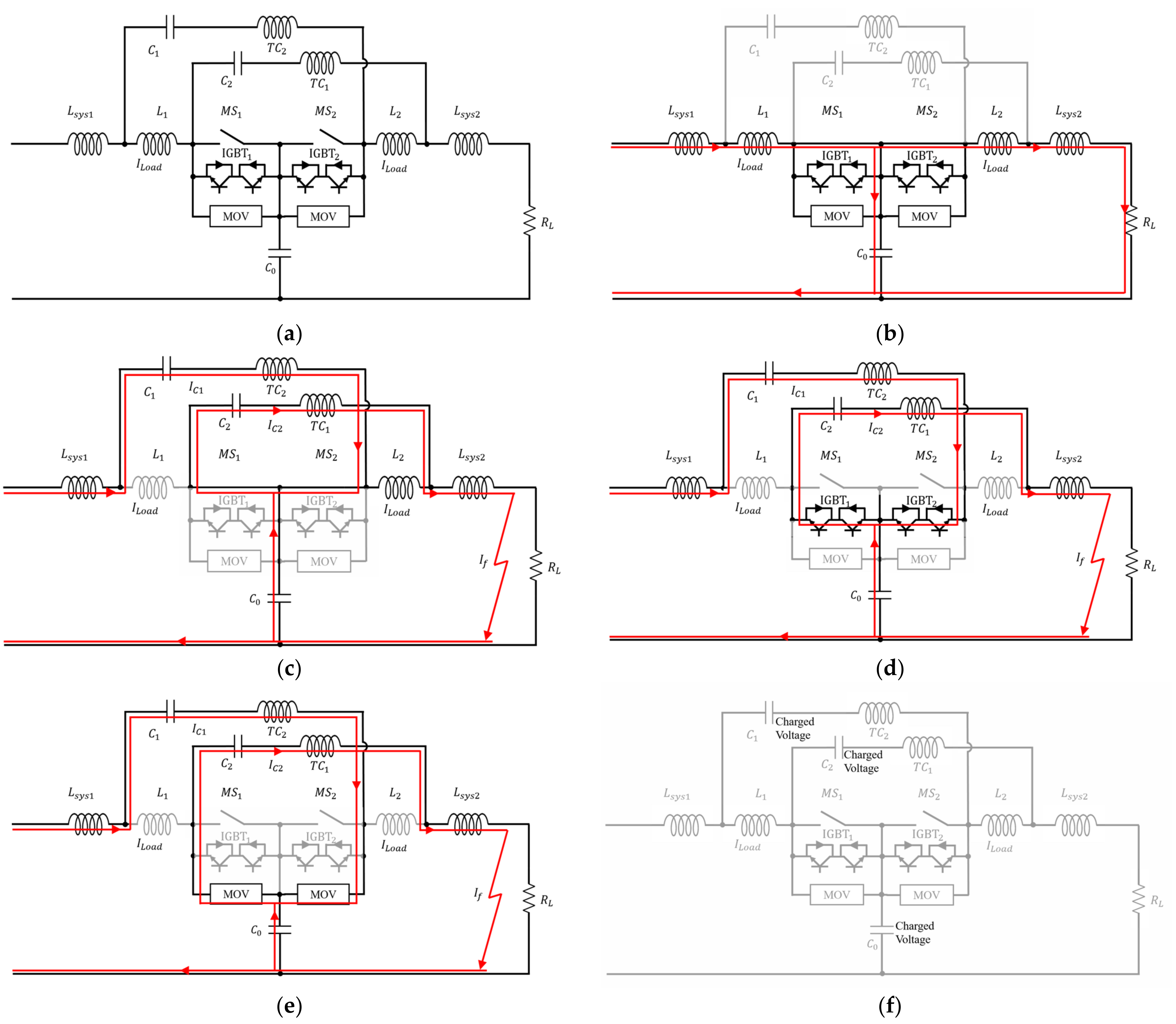
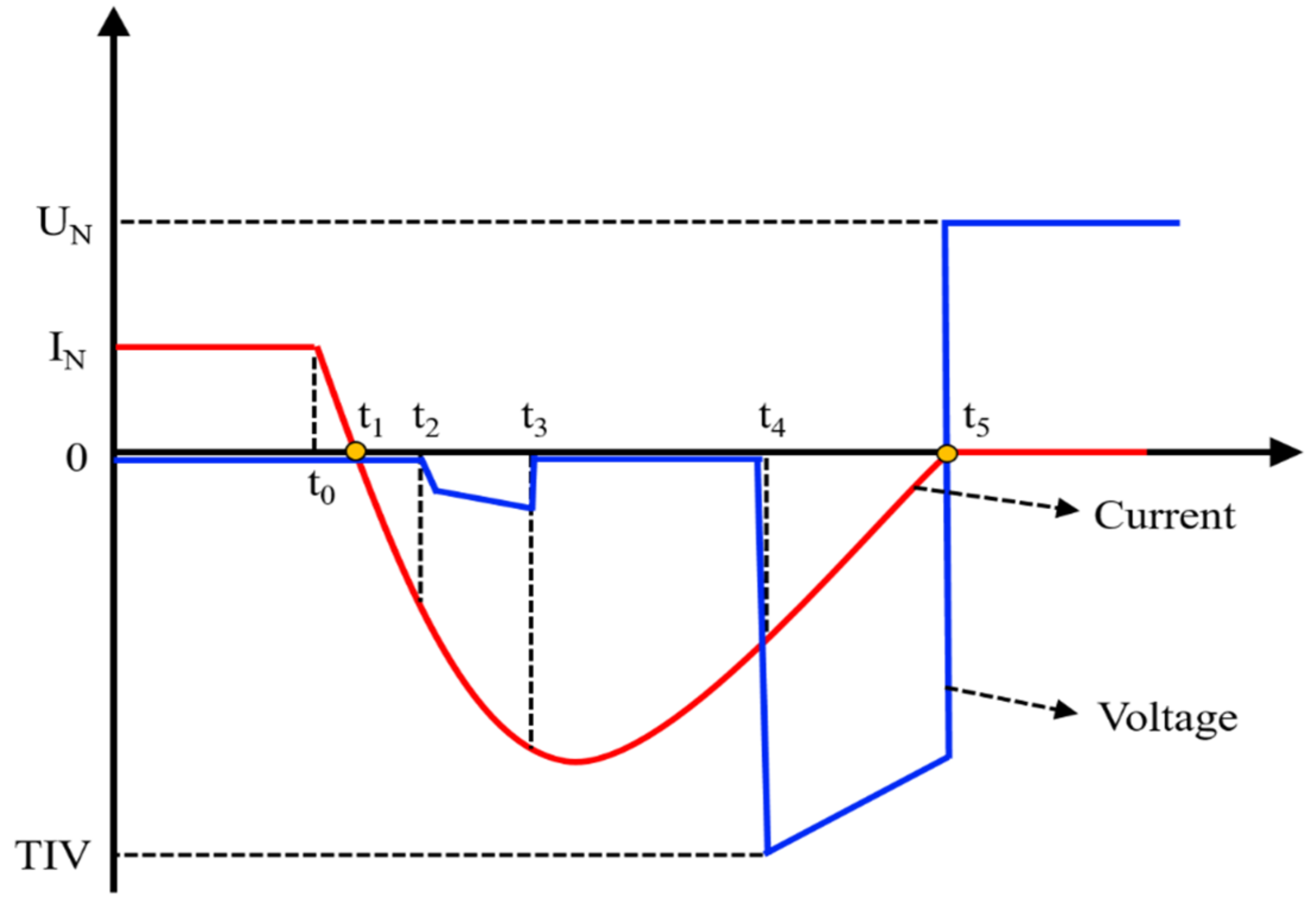
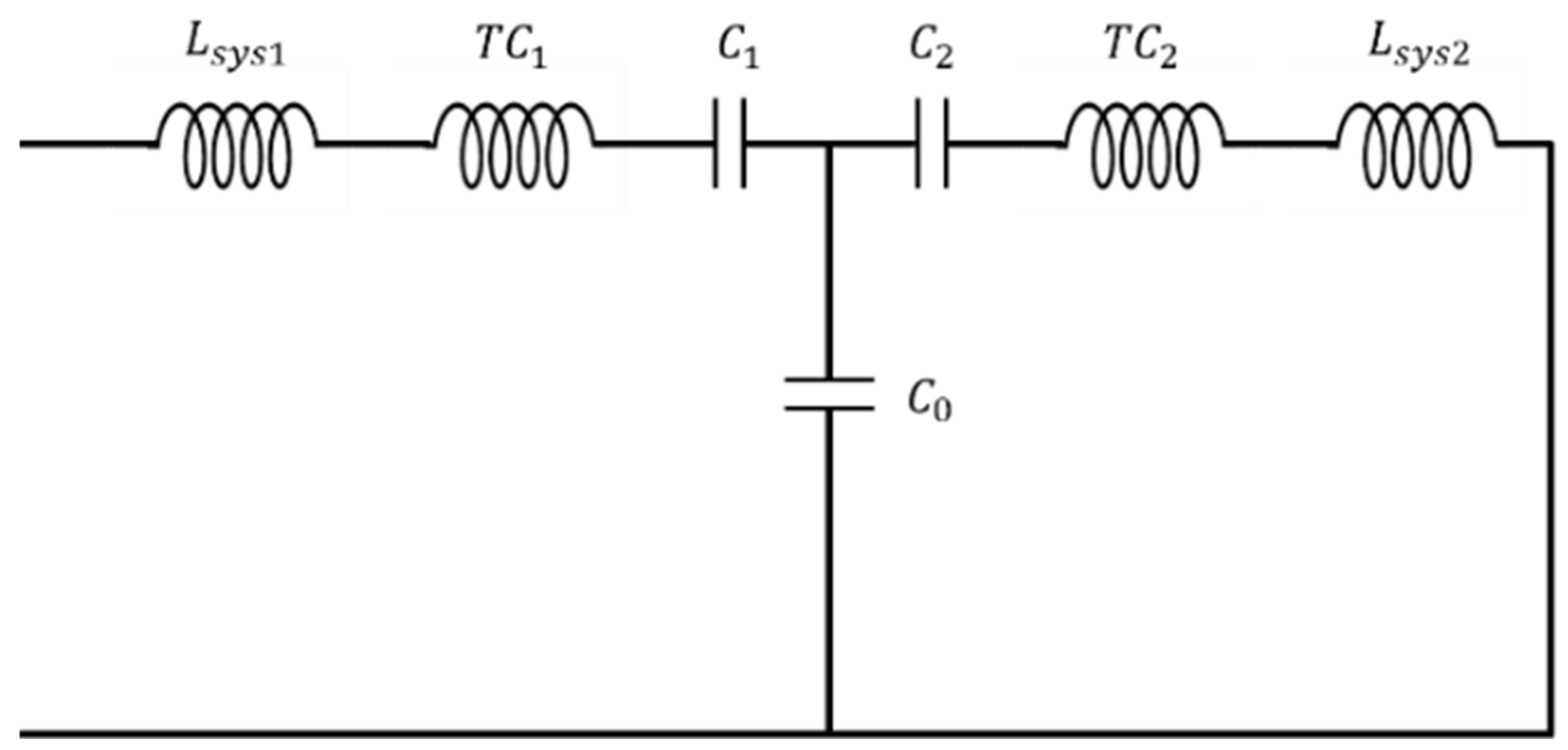
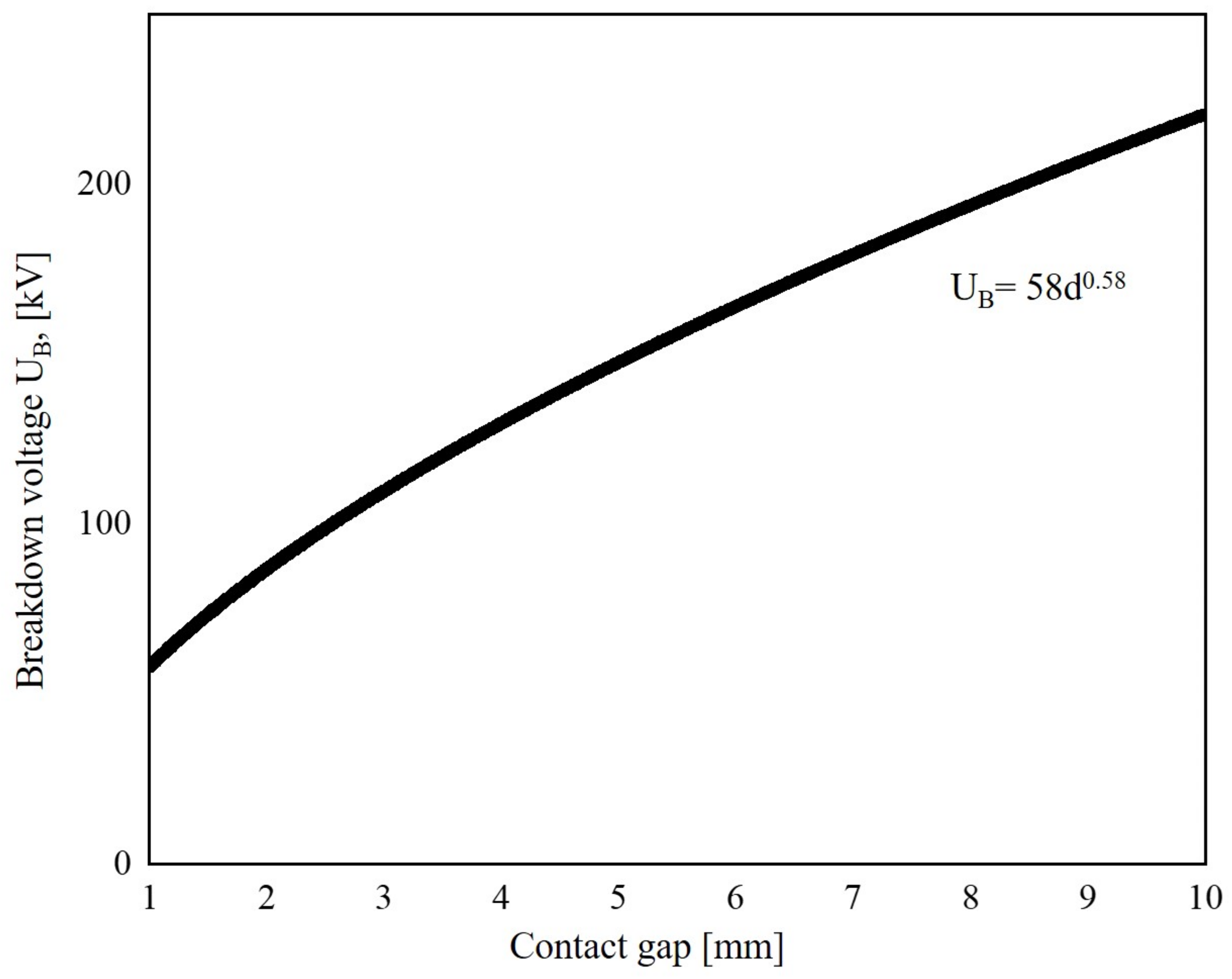
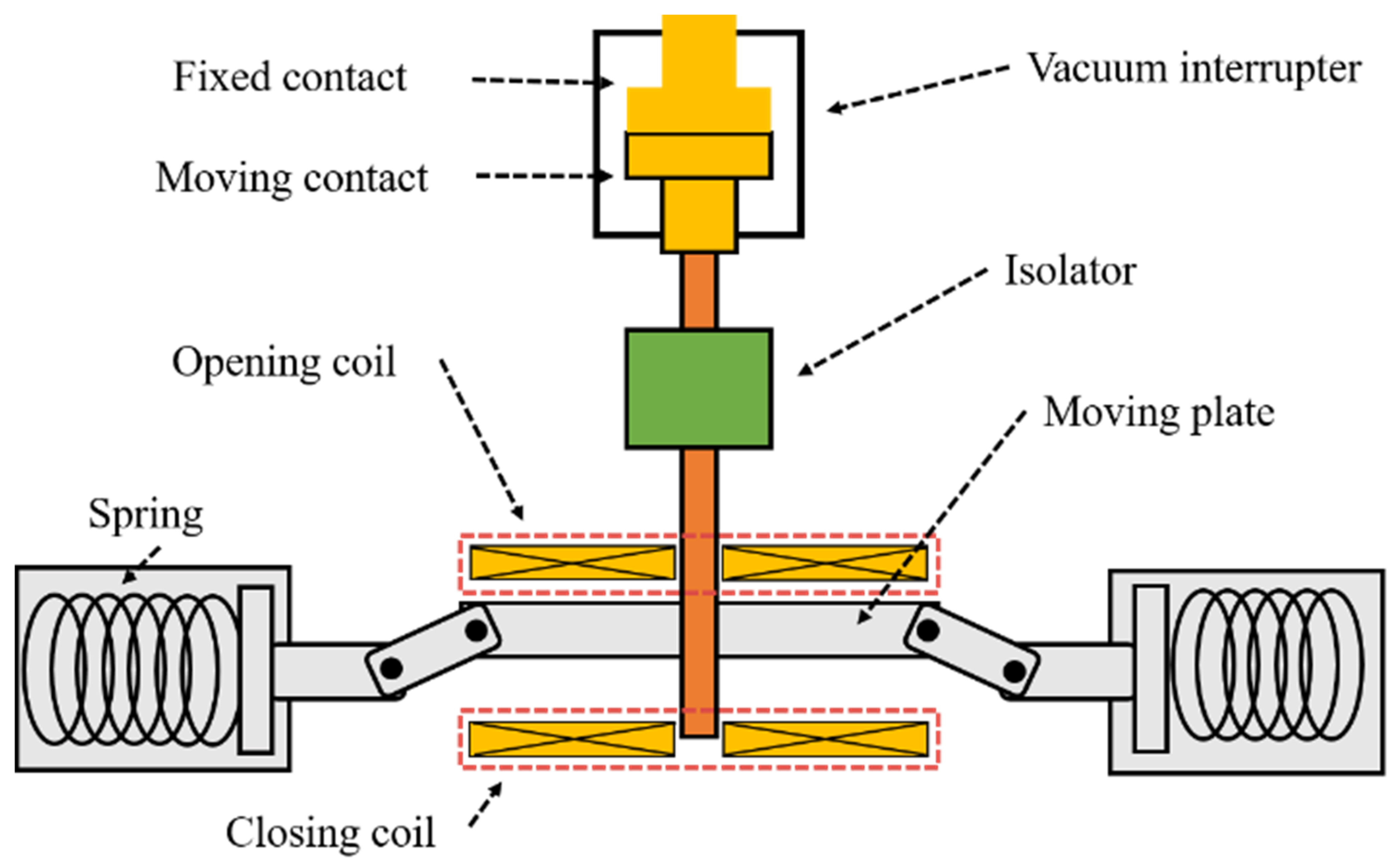



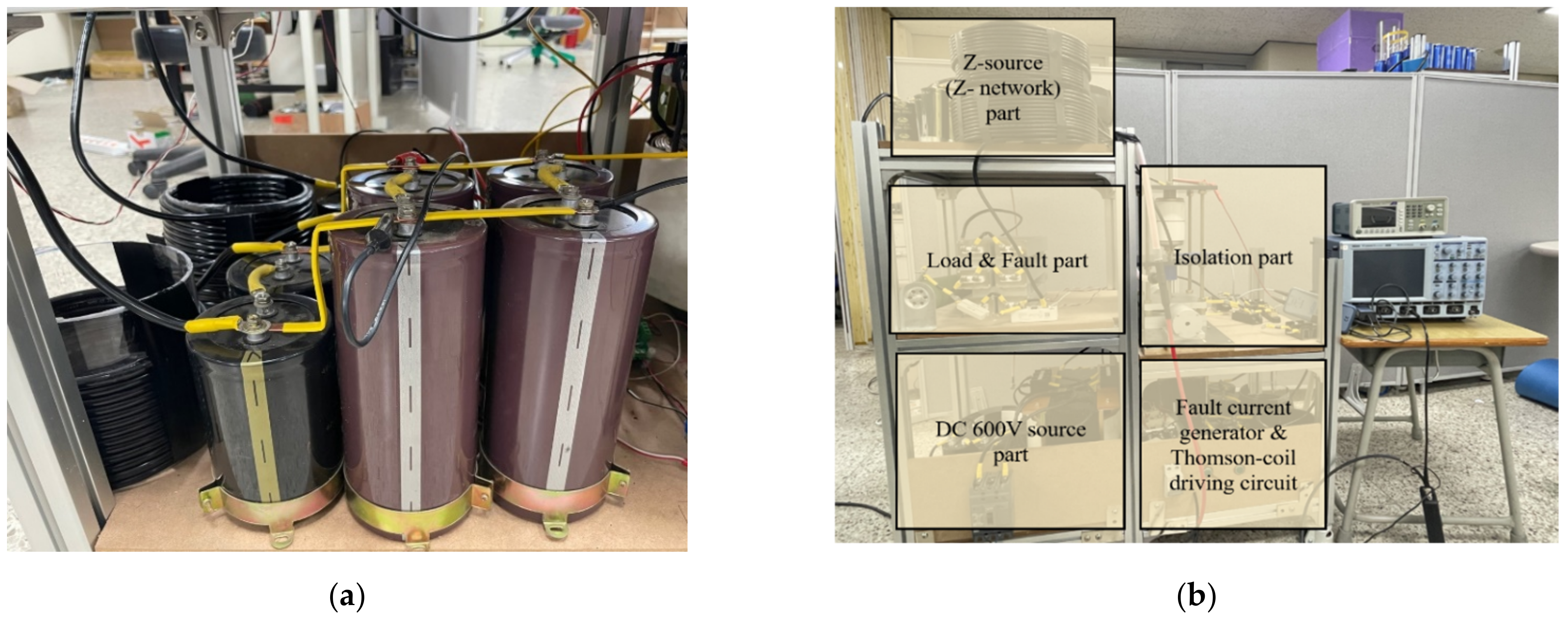
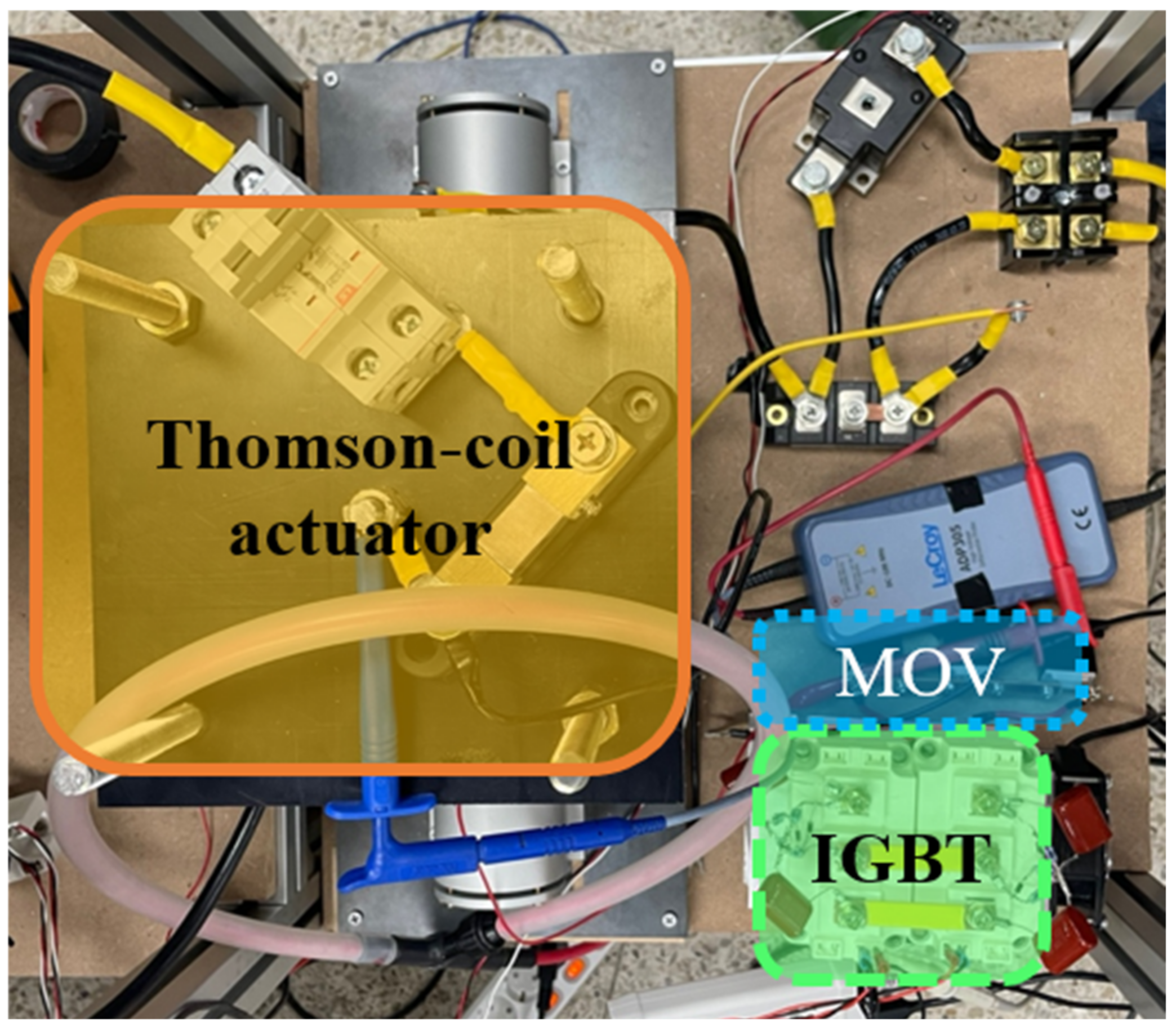
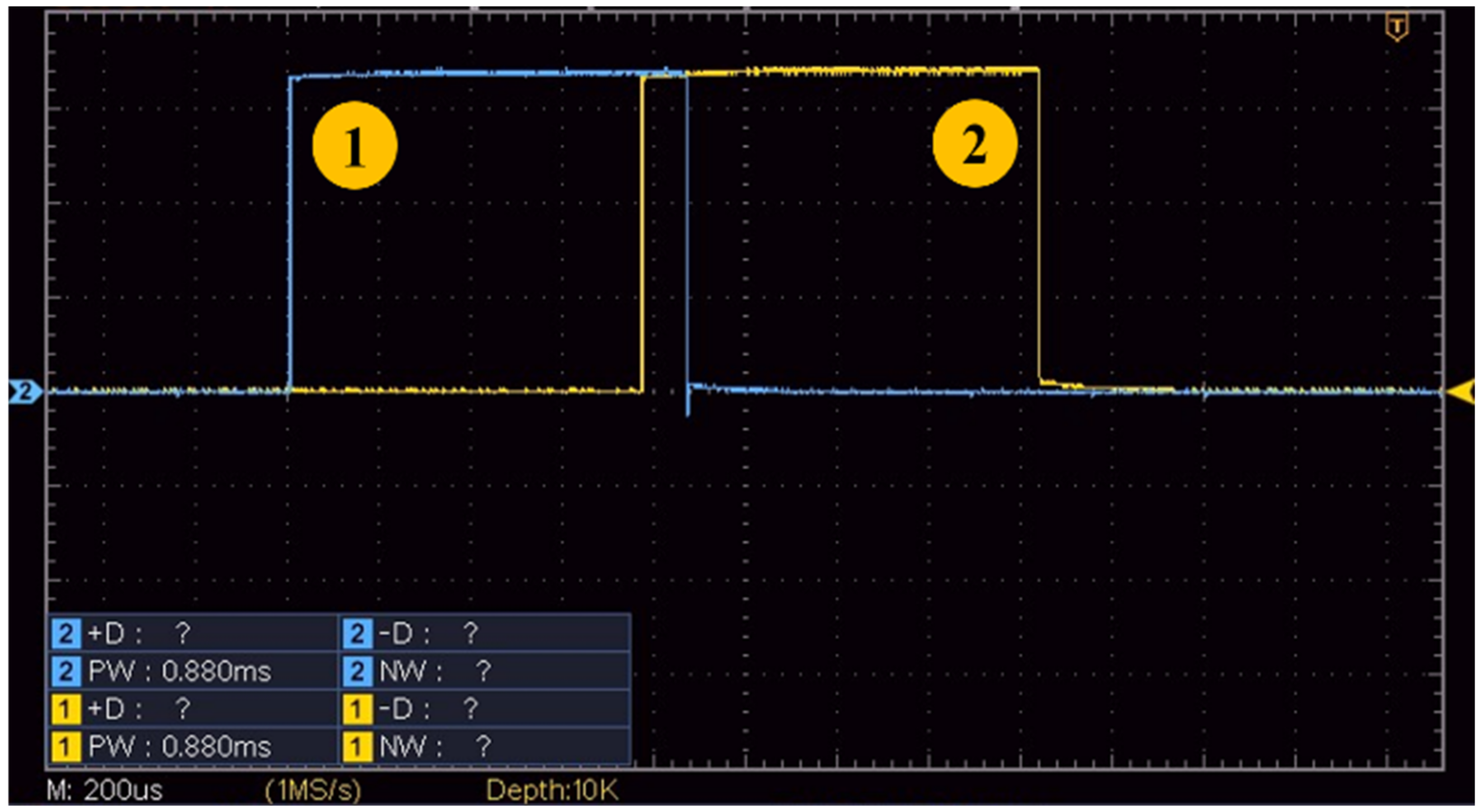
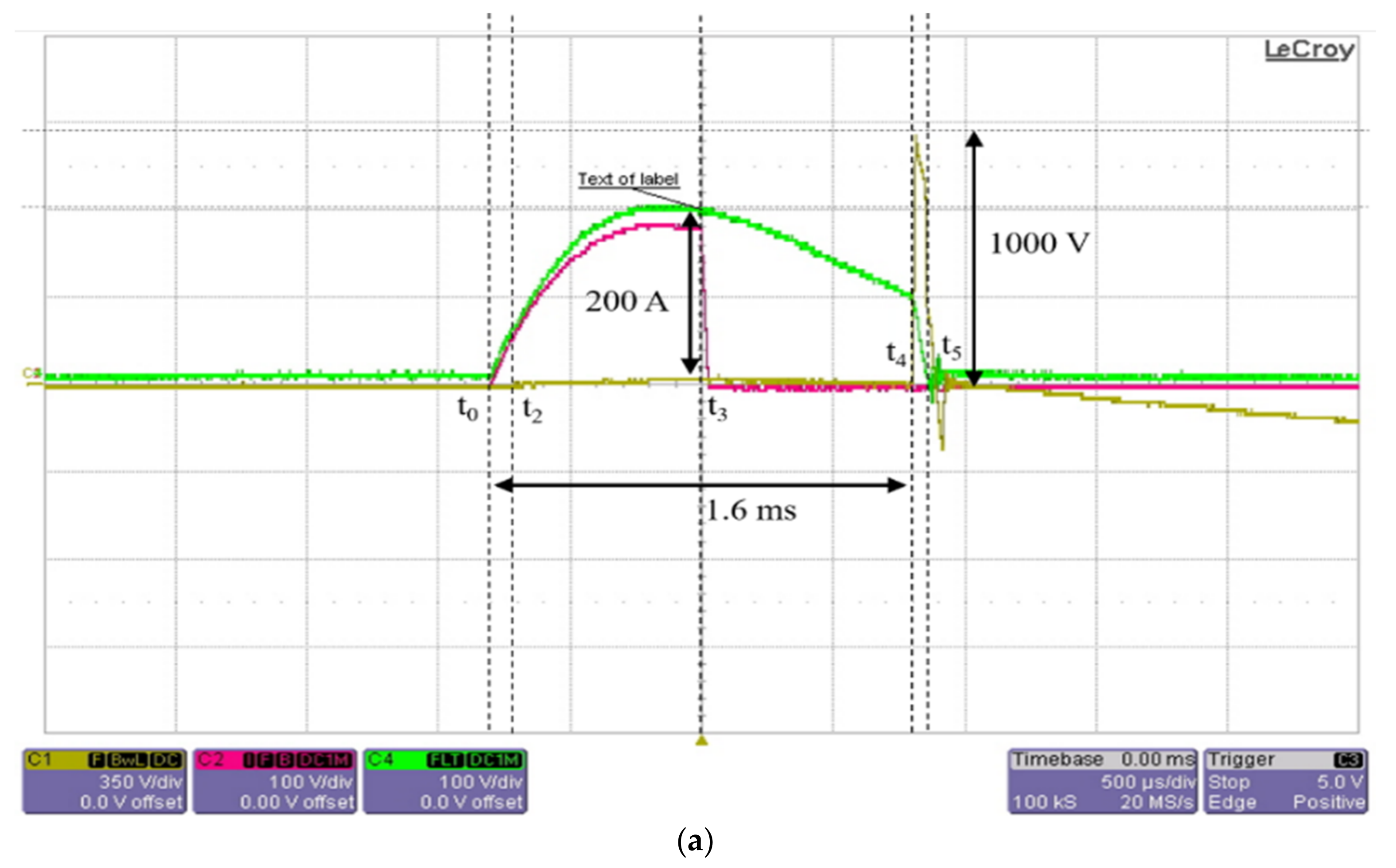
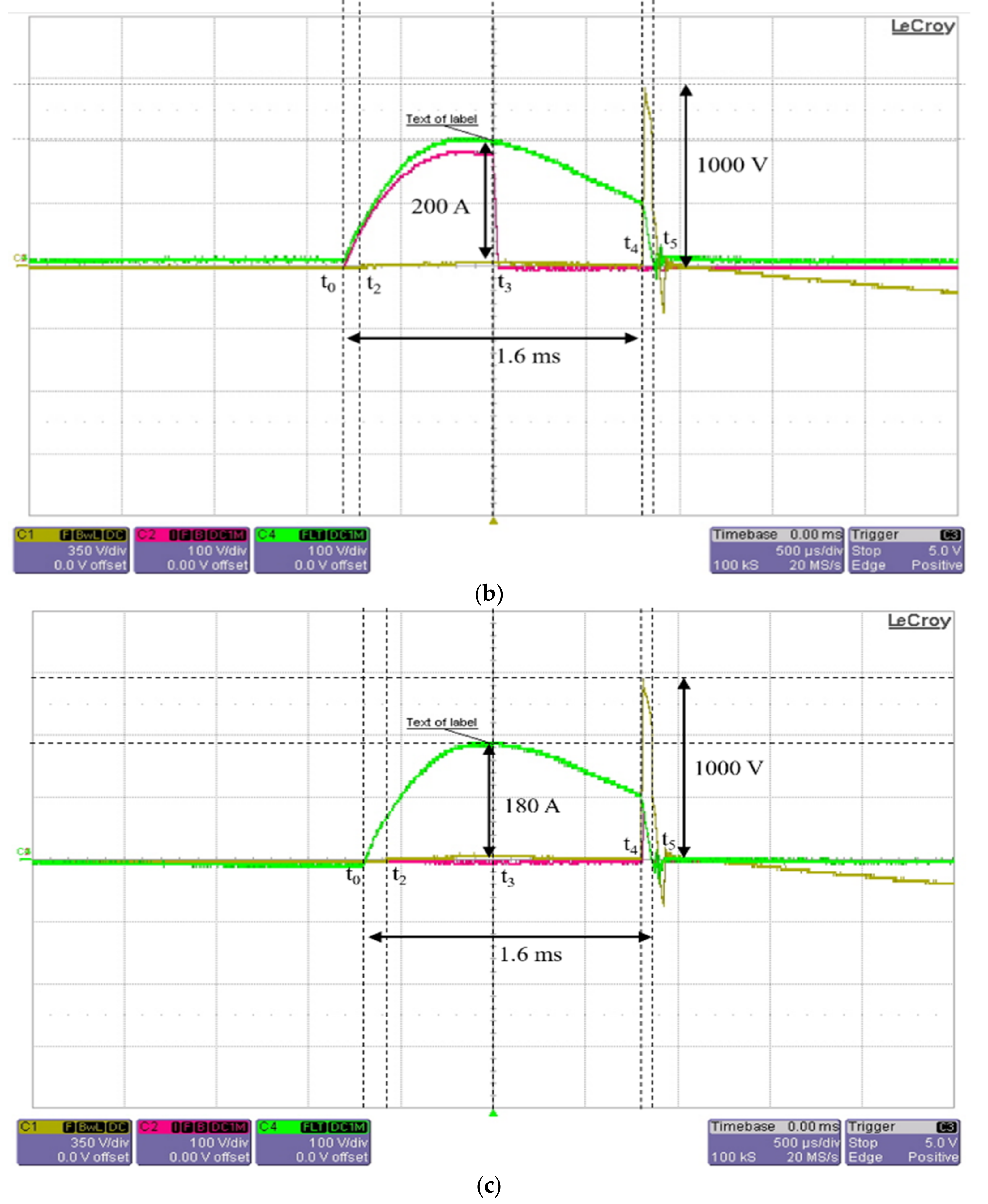
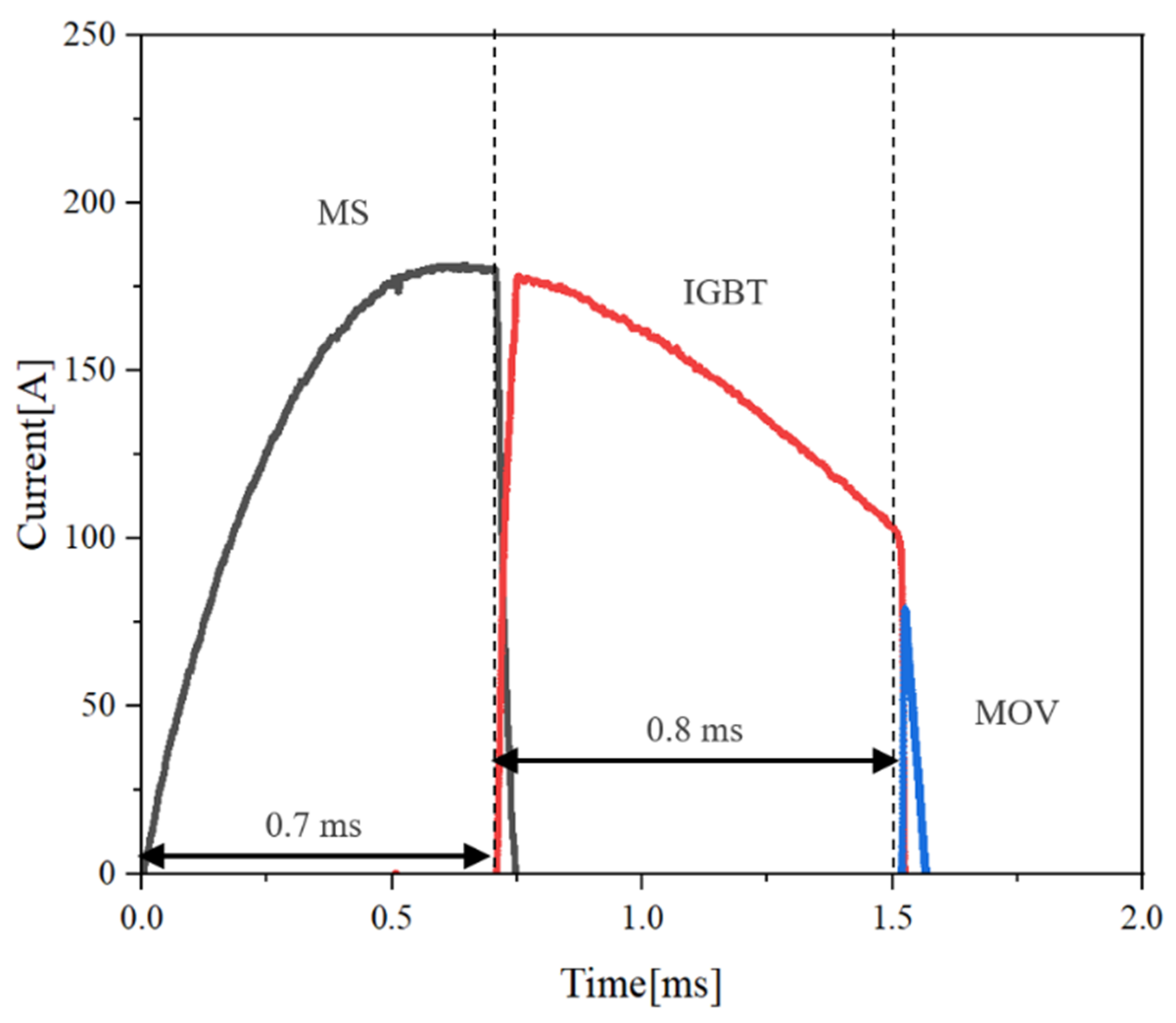

| Symbol | Quantity | Value |
|---|---|---|
| VS | Source voltage | 10 kV |
| C0, C1, C2 | Impedance network capacitance | 1 mF |
| RL | Load resistance | 1 kΩ |
| Rf | Fault resistance | 1 mΩ |
| L1, L2 | Impedance network inductance | 4 mH |
| LSYS1, LSYS2 | System inductance | 1 mH |
| Symbol | Quantity | Value |
|---|---|---|
| VS | Source voltage | 600 V |
| C0, C1, C2 | Impedance network capacitance | 1 mF |
| RL | Load resistance | 250 Ω |
| Rf | Fault resistance | 1 Ω |
| L1, L2 | Impedance network inductance | 4 mH |
| LSYS1, LSYS2 | System inductance | 1 mH |
Disclaimer/Publisher’s Note: The statements, opinions and data contained in all publications are solely those of the individual author(s) and contributor(s) and not of MDPI and/or the editor(s). MDPI and/or the editor(s) disclaim responsibility for any injury to people or property resulting from any ideas, methods, instructions or products referred to in the content. |
© 2023 by the authors. Licensee MDPI, Basel, Switzerland. This article is an open access article distributed under the terms and conditions of the Creative Commons Attribution (CC BY) license (https://creativecommons.org/licenses/by/4.0/).
Share and Cite
Lee, H.-S.; Kang, H.-W.; Rhee, J.-H.; Lee, K.-A. Hybrid Z-Source Circuit Breaker with Thomson Coil for MVDC. Energies 2024, 17, 69. https://doi.org/10.3390/en17010069
Lee H-S, Kang H-W, Rhee J-H, Lee K-A. Hybrid Z-Source Circuit Breaker with Thomson Coil for MVDC. Energies. 2024; 17(1):69. https://doi.org/10.3390/en17010069
Chicago/Turabian StyleLee, Hyun-Seung, Hyung-Wook Kang, Jae-Ho Rhee, and Kun-A Lee. 2024. "Hybrid Z-Source Circuit Breaker with Thomson Coil for MVDC" Energies 17, no. 1: 69. https://doi.org/10.3390/en17010069
APA StyleLee, H.-S., Kang, H.-W., Rhee, J.-H., & Lee, K.-A. (2024). Hybrid Z-Source Circuit Breaker with Thomson Coil for MVDC. Energies, 17(1), 69. https://doi.org/10.3390/en17010069






